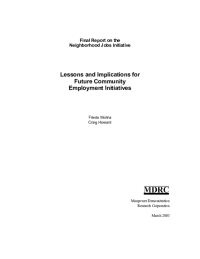Final Report on the Neighborhood Jobs Initiative
Lessons and Implications for Future Community Employment Initiatives
Traditional employment programs have tried to address poverty by focusing on efforts that assist individuals. The Neighborhood Jobs Initiative (NJI) took a different approach. It sought to alleviate concentrated poverty by raising employment levels of entire neighborhoods to match the level prevailing in their metropolitan regions. NJI developers hypothesized that such concentrated efforts, if successful, would gradually transform low-income communities, representing a new approach to neighborhood revitalization. Community organizations with strong ties to neighborhood residents were engaged to lead these efforts. Each was charged with responsibility for identifying ambitious and concrete employment targets and mobilizing public and private partners to reach the targeted outcomes.
Drawing upon the experiences of the lead community organizations during the initiative’s implementation phase, this third and final NJI report begins to answer the overarching questions first posed by MDRC and its funding partners: Is it possible to realize large employment outcomes in targeted communities? Are community-based organizations (CBO) effective vehicles for mobilizing, brokering, and delivering employment programs to underemployed and unemployed residents of low-income communities? What programmatic elements appear to contribute to the goal of raising employment levels in targeted communities?
Key Findings
- Efforts to quantify precisely what was meant by “large employment outcomes” represented a turning point in the initiative and served as a catalyst for bringing partners to the table. Early attempts to implement the vision of NJI faltered when the sites used abstract goals related to the nature and level of expected employment gains. The lead CBOs were unable to convey to partners what scale of effort would be required to realize large outcomes, and they were unable to gauge progress along the way. Once the employment targets were identified and the partners understood and committed to these targets, it became easier for the CBOs to mobilize the levels of effort needed to reach a larger scale of employment outcomes.
- To succeed in reaching community-level employment targets, NJI required an extraordinary effort by the CBOs and their partners NJI required dedicated organizational, human, and financial resources to be successful. Distinct staff capacities were required at different stages of the initiative, and the lead organization had to be willing to give NJI priority over its other activities and be prepared to dedicate a significant amount of senior staff’s time to the effort.
- CBOs with strong neighborhood connections are ideally suited for mobilizing residents and partners to achieve positive programmatic advantages. The quality of CBO relationships with neighborhood residents and knowledge of their employment barriers contributed to the type, quality, and accessibility of employment services offered, thereby improving early progress in reaching their employment targets.
- The scale of operations achieved by NJI sites suggests that it is possible to raise employment rates in low-income neighborhoods. The initiative ended after just two years of program implementation, and none of the sites had achieved its five-year saturation targets within the time allocated. But early achievements suggest that a number of sites were on a trajectory to realize large outcomes, thereby changing the employment profiles of their respective communities.
- A neighborhood-focused employment saturation strategy is not appropriate for all low-income neighborhoods. The NJI experience suggests that more stable neighborhoods with strong local identities experience the greatest benefit from a place-based employment approach like NJI.






